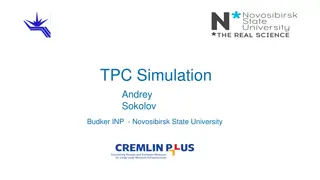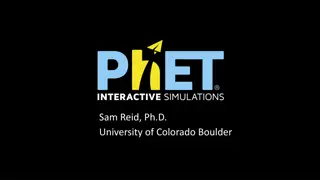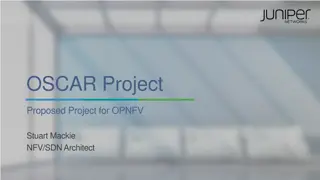Comprehensive Overview of OSCAR v3.1: A Compact Earth System Model with CMIP6 Simulations
Showcasing the compact Earth system model OSCAR v3.1 and its CMIP6 simulations. OSCAR is a reduced-form Earth system model calibrated to emulate complex models, focusing on radiative forcing, temperatures, precipitation, ocean heat content, aerosols, ozone, and more. Historical periods and scenarios are accurately reproduced, with a strong emphasis on aerosols in OSCAR 3.1. The model undergoes 99 experiments with probabilistic setups, assessing observational constraints and probabilistic outputs across varied configurations and outputs.
Download Presentation

Please find below an Image/Link to download the presentation.
The content on the website is provided AS IS for your information and personal use only. It may not be sold, licensed, or shared on other websites without obtaining consent from the author.If you encounter any issues during the download, it is possible that the publisher has removed the file from their server.
You are allowed to download the files provided on this website for personal or commercial use, subject to the condition that they are used lawfully. All files are the property of their respective owners.
The content on the website is provided AS IS for your information and personal use only. It may not be sold, licensed, or shared on other websites without obtaining consent from the author.
E N D
Presentation Transcript
Showcasing the compact Earth system model OSCAR v3.1 with CMIP6 simulations Yann Quilcaille, Thomas Gasser yann.quilcaille@env.ethz.ch gasser@iiasa.ac.at EGU2021, 26 Apr 2021 EGU21-15630 in session CL5.2.1
OSCAR: Reduced-form Earth system model, whose modules are calibrated to emulate the behaviour of complex models Code (python) open-source at: https://github.com/tgasser/OSCAR Developing philosophy: starting simple, and then increase the number of processes and interactions Radiative forcing OSCAR is not an emulator per se, it is a combination of emulators +: adding processes and feedbacks - : exactly emulating a given model Temperatures Precipitation Ocean Heat Content Aerosols cloud effects O3 Stratosphere Probabilistic setup <1h for 100 years with 1000 members Aerosols direct effects O3 Halogenated atm. chemistry Troposphere Biogeochemical feedbacks of OSCAR: land-use CO2 emissions, wetlands CH4 emissions, biomass burning, albedo change, permafrost carbon thaw and release, CH4atm. chemistry Biomass burning Lagged concentrations Surface albedo N2O atm. chemistry CH4Wetlands Carbon cycle Land Carbon cycle Ocean Permafrost Book-keeping module for the land carbon cycle regionalized over world regions (GCB)
Historical period correctly reproduced Scenarios correctly reproduced (low on SSP5-8.5?) Strong aerosols OSCAR 3.1 RCMIP phase 2: Nicholls et al, 2021, submitted (http://doi.org/10.1002/essoar.10504793.1)
99 experiments (75 CMIP6 + 24 RCMIP) Probabilistic setup (10k members) Total: 569,700,000 simulated years OSCAR as a combination of emulators: every configuration is a physical world, some may not be realistic Identification of diverging configurations across all experiments: keeping the same selection for all Assessed ranges used as observational constraints PDF from ONE assessed range Likelyhood for 1 configuration of OSCAR and ONE assessed range Value for 1 configuration of OSCAR Probabilistic outputs for all these experiments
Overall, good. Carbon cycle: 1940s plateau missed under esm-hist, classical from many ESM Strong RF of aerosols, compensated by a strong RF of trop. ozone. Climate system: correctly reconstructed.
6.9 0.5 7.4 OSCAR 3.1 calibrated on CMIP5: closer agreement for the unconstrained version 0.3 0.2 -0.4 0.3 -0.4 0.3 OSCAR v3.1 CMIP5 CMIP6 Unconstrained Constrained Increase from CMIP5 to CMIP6 but Decrease in climate metrics when constraining 3.17 0.63 3.28 [2.36-4.25] 2.78 0.47 2.63 [2.36-3.75] Gregory s method 3.2 0.7 3.7 1.1 ECS (K) 2.74 0.52 2.61 [2.02-3.67] 2.51 0.33 2.45 [2.08-3.22] Equilibrium TCR (K) 1.78 0.28 1.77 [1.37-2.26] 1.66 0.16 1.62 [1.41-1.96] 1.8 0.40 2.0 0.4 Additional effects on ECS from aerosols: lower temperature at equilibrium TCRE (K EgC-1) 1.67 0.40 1.63 [1.08-2.37] 1.44 0.20 1.41 [1.15-1.82] 1.63 0.48 [0.8-2.4] 1.77 0.37
? ? (PgC K-1) at 2xCO2 ? ? (PgC ppm-1) at 2xCO2 Model Land Ocean Land Ocean OSCAR v3.1 1.26 0.47 1.05 0.03 -43.2 23.8 -21.6 6.3 constrained OSCAR v3.1 1.14 0.64 1.05 0.03 -37.6 26.4 -21.0 5.7 unconstrained CMIP5 1.15 0.63 0.95 0.07 -37.0 25.5 -9.4 2.7 CMIP6 1.22 0.40 0.91 0.09 -34.1 38.4 -8.6 2.9 OSCAR 3.1 calibrated on CMIP5: closer agreement for the unconstrained version Climate sensitivity of the ocean too high
Good performances over scenarios, although: Constraining using assessed ranges take OSCAR away from CMIP6 ranges RF aerosols and trop. ozone too strong. need calibration on CMIP6
CO2as main driver of the land carbon cycle of OSCAR Replacing croplands by grasslands: -31 26 PgC No land-use: -152 44 PgC In 2010 Shifting cultivations: -8 2 PgC Wood harvest: -16 4 PgC Significant impact of 1700-1850 on 1850-2010
More optimistic LULCC: More carbon stored in land But weak increase in the RF from albedo of LCC Change in T cannot be estimated: concentrations-driven
SRM offsets most of the warming But change in land carbon stocks Change in biomass burning emissions Change in RF of aerosols, ozone, In 2100, G6 warmer by ~0.05 C, higher storage of carbon and precipitations decreased by ~ 26mm/yr
OSCAR 3.1: fast, flexible and accurate reduced complexity model Unconstrained, close to CMIP5. Constraining improves projections, but draws away from CMIP6 range Efficient tool for the exploration of scenarios, assumptions, uncertainties, Next upgrades: update on CMIP6, improvement of the climate system, oceanic carbon cycle, Questions, remarks? (Results for all experiments in a paper, soon submitted)
Examples of times to return within 10% of the value at the end of the increase period after the end of the decrease period: Land carbon stock: 26 years GSAT: 110 years Ocean carbon stock: 19% after 1000 years























